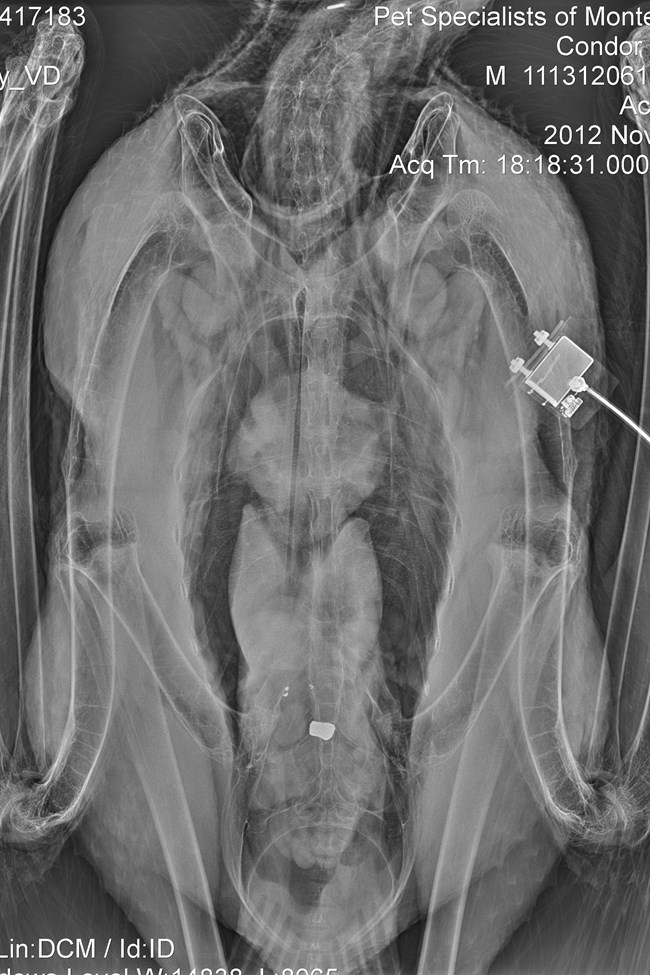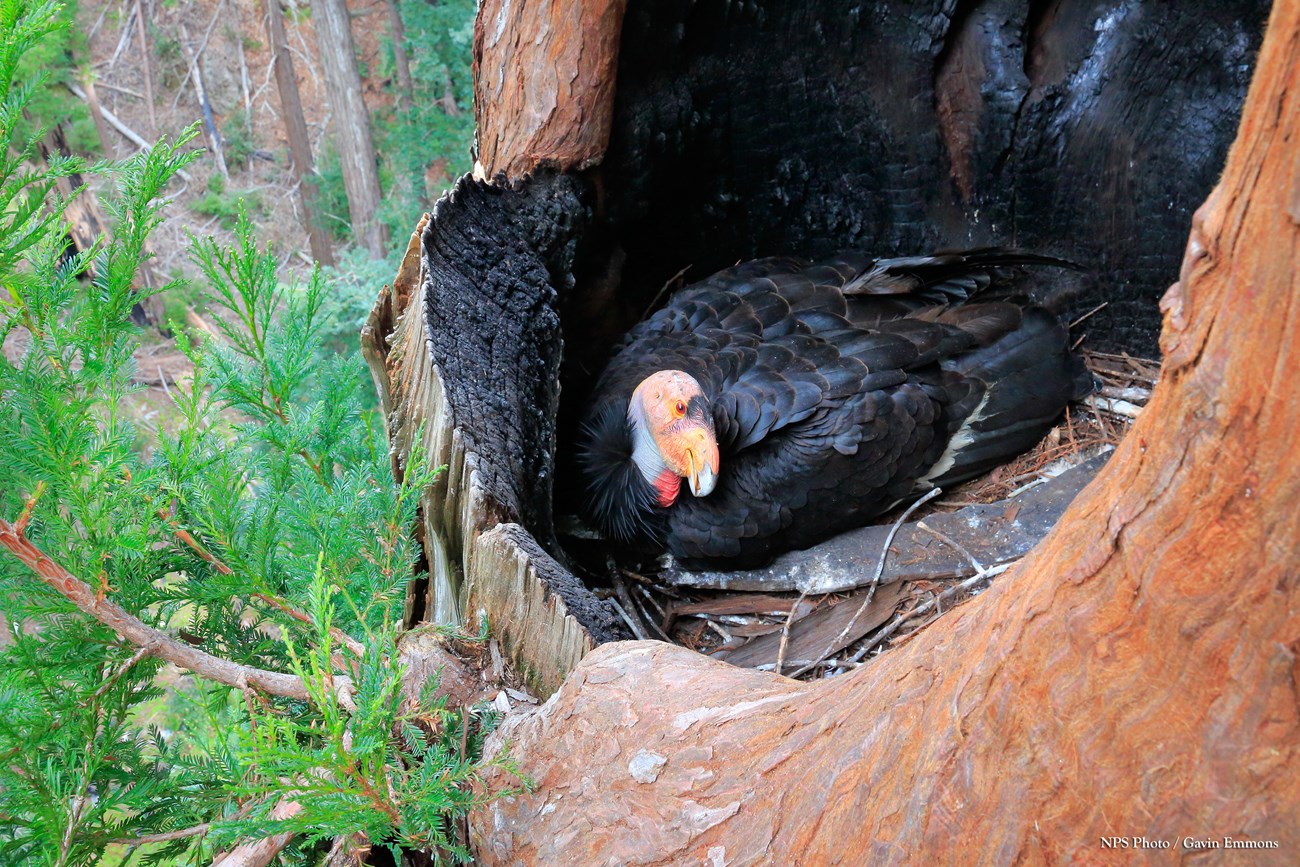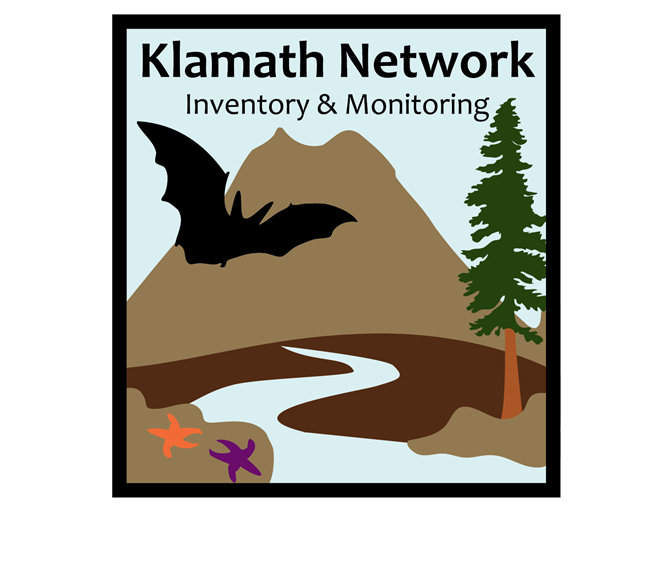Last updated: January 25, 2024
Article
California Condor in the Pacific Northwest

NPS/Gavin Emmons
General Description
An enormous winged scavenger is slowly returning from the brink of extinction to its historical haunts in western North America. In 2022, this includes soaring over Pacific Northwest skies for the first time in a century.
The California condor, Gymnogyps californianus, is the largest soaring land bird on the continent, stretching 2.8 m (9.5 ft) from wing to wing, and weighing about 8.5–10 kg (18–22 lbs). A New World vulture in the family, Cathartidae, its closest relative is the Andean condor of South America (Vultur gryphus).
Up close, the brownish-red eyes of the adult condor are set in a bare, yellow to reddish-orange colored head. Its long, hooked beak is ivory-colored and mostly coated by fleshy tissue. A ruff of feathers at the base of its neck covers or exposes the entire neck for thermal regulation. Bright purplish red patches of skin on the neck and crop (upper breast) area can be highlighted during displays. Its body is mostly black, with a long triangle of white under its wing and a fainter white bar above. Males and females look similar. Juveniles are dark overall with black bills, dark, downy heads, and mottled white and dark gray under the wing, taking several years to attain adult coloration. Befitting a scavenger’s life, condor feet are flat with short claws better suited to walking (even running) than to killing or carrying prey. The legs may appear white from a coating of the bird’s own excretions (uric acid) for evaporative cooling, a process known as urohydrosis.
In flight, the California condor may be confused with eagles and vultures. The condor’s unflapping, steady soaring flight on horizontally held wings has the look of a small airplane, unlike the rocking flight of the smaller turkey vulture (Cathartes aura), whose wings tilt slightly upwards. Bald and golden eagles (Haliaeetus leucocephalus and Aquila chrysaetos, respectively) are also steady flyers with horizontally held wings, but they are significantly smaller (2.5 ft shorter wingspread). The dead giveaway, however, is spotting a large, numbered tag on one or both wings, which helps researchers track individual birds as part of the recovery effort.
Habitat and Distribution
Fossils show that California condors had a wide distribution in North America, including southern Canada, the eastern United States and south into Mexico, before the late Pleistocene megafauna extinctions around 13,000 years ago. By the early 1900s, condors documented a century earlier in 1804–1806 by Lewis and Clark along the Columbia River and Pacific Northwest coastlines were mostly gone. By 1940, only a small population in the coastal mountains of southern California remained. Thanks to reintroduction efforts, condor populations now occur in southern and central California, Baja (Mexico), and the Grand Canyon area of northern Arizona. The Yurok Tribe in northern California is leading efforts to reintroduce condors to Yurok Ancestral Territory and the Pacific Northwest.
Condors are habitat generalists, foraging widely for carcasses from sea level to high elevation meadows. They glide for long distances in search of food over very large home ranges. One telemetry study estimated the core foraging area of a pair of breeding condors at 2500–2800 km2. Relying on keen sight to find food, they tend to forage in relatively open conditions that are made accessible by consistent air currents or thermals for soaring and gliding.
In southern California, condors nest in chaparral covered mountains, foraging in the nearby valley foothills and grasslands. Central California condors will nest in dead-top redwoods (Sequoia sempervirens) as well as in cliff cavities and in rocky outcrops.
Habitat in the Pacific Northwest appears favorable for reintroduction. Suitability studies point to the abundance of mature forests (with big redwood trees), open prairies and woodlands for foraging, plentiful marine mammal carcasses along coastlines, and relatively low levels of lead, DDT and other potential contaminants in the region.
Behavior and Diet

NPS/PINN
California condors are social birds, gathering for roosting, bathing, and foraging. Roost sites may include a horizontal tree limb or cliff ledge, where they may sleep lying flat or standing up. They bathe frequently, especially after feeding, and choose sites that facilitate take-off, such as the top of a waterfall. Occasional conflicts do occur, during which the birds may inflate the air sacs in their gular (throat) and neck areas to show off their colored skin. Social learning is important, as juveniles learn from older birds where to find nesting and foraging areas. During the breeding season, condors separate into individual pairs but still join other condors to feed and bathe.
As obligate scavengers, eating only dead animals, condors must travel widely in search of food. They are extraordinary gliders, capable of long distance flights (400 km!) and rarely flapping except during landing and take-off. A round trip of 100–240 km between the nesting and foraging grounds is not unusual. Sharp eyesight is thought to be their main foraging tool, rather than smell. They are often alerted to food by other scavengers, like turkey vultures, common ravens (Corvus corax), and eagles.
California condors feed primarily on large mammal carcasses. Early in their evolution, condors scavenged Pleistocene megafauna. Currently they eat dead deer and elk, domestic livestock, and marine mammals, though not exclusively. Unable to break apart the bones of these larger mammals, they feed primarily on the soft tissue. To supplement their calcium needs, therefore, condors ingest bone chips from smaller prey, such as ground squirrels (Spermophilus spp.). This need for calcium from other sources is one potential explanation for an odd but lethal habit: bringing small pieces of metal (e.g., bottle caps, spent bullet casings), glass, and plastic trash back to their nests, which the nestlings may, unfortunately, ingest. The most significant dietary threat to condors, however, is poisoning by ingesting the remnants of lead ammunition in hunter-killed deer and other mammals. Lead poisoning is currently the main threat to their recovery.
Breeding

NPS/Gavin Emmons
Condors form strong and durable monogamous pair bonds (though cooperative breeding among 3 adults raising a chick has been observed). In late fall to early spring, courtship begins with side-by-side soaring through the nesting territory. The pair engages in mutual grooming—nibbling at the skin and feathers of each other’s head and neck area. Courtship displays include wing-out, where the male extends and lowers his head, holds his wings out with tips drooping down and struts his legs as he circles his mate, sometimes inflating his air sacs. The pair visits several sites together before choosing a nest, which they may maintain for multiple breeding cycles. It may be on a cliff ledge or in a pothole in mountainous areas, or in the cavity of a coast redwood or giant sequoia (Sequoiadendron giganteum).
In Jan–Apr, the female lays a single, pale blue or greenish-white egg directly onto the nest substrate without adding any nesting material, although existing debris may be shaped in a rough bowl. Both adults alternate incubating the egg, sometimes for a multiday, unbroken (!) shift. If the nest fails during incubation, the female can lay a replacement egg. This is called “double clutching” and has been crucial to the species’ recovery. After 8 weeks, a downy white chick hatches (Apr–June). Both parents take turns brooding the youngster and feeding it by regurgitation. After 5.5 to 6 months, (early Sep–mid-Nov) the nestling begins the clumsy affair of fledging, with plenty of missed and awkward landings. Soon the youngster is flying with its parents to roosting and foraging areas and will remain with them for the next 6–12 months. This prolonged dependency means that females do not breed more than 2 of every 3 years, rather than yearly. Juveniles develop and learn from other, older condors over the next 6 to 8 years until reaching sexual maturity.
Condors are thought to live up to 60 or 70 years, but accurate information is not possible with such high mortality over the past century.
Ecology
Adult condors have few natural predators, though they often defer to golden and bald eagles at feeding sites. Condor eggs and nestlings occasionally fall prey to golden eagles and ravens.
As scavengers, condors are vital for nutrient recycling, opening up and breaking down carcasses into smaller chunks for smaller scavengers. Vultures have gut microbiomes resistant to bacterial toxins that grow on decaying tissue, like botulism. In this way, they help prevent disease outbreaks by ingesting and removing toxins from circulation.
Cultural Value
California condors once soared over Pacific Northwest skies as far north as British Columbia. They are culturally important to tribes in the region, including the Hupa, Karuk, Wiyot, Chilula, and Tolowa Dee-ni’. Condors—prey-go-neesh—are sacred to the Yurok Tribe, who is leading an effort to reintroduce the condor in northern California. The first birds were released into the wild in 2022.
Conservation
The dramatic story of the California condors' near extinction and recovery took focus in the mid-1900s, when awareness grew of their decline. Early on, the causes were thought to be habitat loss, incidental poisoning of various kinds from carcasses, and human disturbance. In 1967, the federal government listed the 60 or so remaining condors as endangered. A recovery team led by the U.S. Fish and Wildlife Service began implementing the California Condor Recovery Plan in 1975. But by the early 1980s condors had plummeted to a low of about 23 birds and all the remaining free-flying birds were captured for captive breeding by 1987. Intensive studies since then have identified the primary cause of mortality as lead poisoning when condors ingest fragments of lead ammunition from gut or offal piles. Secondary threats include powerline strikes and direct shooting.
The recovery program has focused on captive breeding, enhanced by double clutching pairs to produce more eggs. Before release, juveniles are conditioned to avoid electrocution by power poles. Condors released into the wild are regularly provided clean, lead-free food. In 2020, 329 free-flying condors (of 504 total living birds) roamed the skies in California, Arizona, and Mexico. The Pacific Northwest has begun adding to these counts.
Unfortunately, free flying condors are still ingesting toxic levels of lead from contaminated remains. Despite treatment, some don’t survive. Because of this, condors are dying at rates too high to sustain a wild population without our help. Hunters play a critical role as conservation partners by switching to non-lead hunting ammunition, such as steel or copper. All community members can help keep microtrash out of the environment. Finally, always keep your distance from a wild condor, for the sake of maintaining its wildness, its safety, and your own.
Where to See
Watch for condors soon in the Pacific Northwest, beginning at Redwood National and State Parks.
Learn More
https://www.yuroktribe.org/yurok-condor-restoration-program
https://www.nps.gov/redw/learn/nature/condors.htm
https://huntingwithnonlead.org/
https://www.ventanaws.org/condor_cam.html#nestCam

Download a pdf of this article.
Prepared by Sonya Daw
NPS Klamath Inventory & Monitoring Network
Southern Oregon University
1250 Siskiyou Blvd
Ashland, OR 97520
Featured Creature Edition: March 2022
